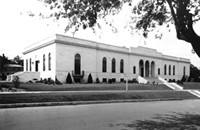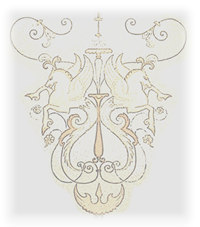
[Austin-Travis County Collection at Main Library], 1972, PICA 01594 detail
AHC History
In 1955, the Austin Public Library established a small file devoted to local history called the Austin-Travis County Collection. Through the hard work of Helen Swanson and the collection's first curator, Katherine Drake Hart, the Austin-Travis County Collection grew from a single file folder into a separate section of the Austin Public Library's Reference department. After the opening of the new John Henry Faulk Central Library and due to the efforts of the second curator of the Austin History Center, Audray Bateman Randle, along with community leaders such as Sue McBee, then-Mayor Carole McClellan, and members of the Austin History Center Association, the original central Austin Public Library building became the Austin History Center. See more events in the development of the Austin History Center on our timeline or learn about the history of our beautiful building.
Timeline
Timeline

-
1955 - The Austin-Travis County Collection is created as a part of the Austin Public Library.
-
1955 - Students compete in the first Historical Essay Contest sponsored by the Austin-Travis County Collection. The contest will be held each year for the next 20 years.
-
1960 - The Niles-Graham-Pease family papers are donated to the Austin-Travis County Collection nearly quadrupling the collection's size.
-
1961 - Katherine Drake Hart becomes curator of the Austin-Travis County Collection.
-
1965 - Friends of the Austin Public Library begin Waterloo Press in order to feature manuscript and photographic material from the Austin-Travis County Collection.
-
1975 - Audray Bateman Randle becomes curator of the Austin-Travis County Collection.
-
1979 - The original 1933 Austin Public Library building is occupied solely by the Austin-Travis County Collection when the new central library is complete.
-
1980 - Austin History Center Association is formed to support the creation of the Austin History Center.
-
1983 - The Austin-Travis County Collection formally becomes the Austin History Center.
-
1983 - Judge Trueman O'Quinn donates his substantial collection of O. Henry material to the Austin History Center.
-
1987 - The Austin History Center constructs a photo reproduction lab to facilitate preservation of photographic images.
-
1989 - Biruta Celmins Kearl becomes curator of the Austin History Center.
-
2000 - The Austin History Center creates new Neighborhood Liaison positions (now called Community Archivists) to broaden its acquisitions program.
-
2003 - Sue Soy becomes curator of the Austin History Center.
-
2005 - The Austin History Center celebrates its 50th anniversary.
-
2008 - Michael C. Miller becomes Division Manager of the Center in March after serving as the Acting Manager since October 2007
-
2013 - The Austin History Center's building at 810 Guadalupe turns 80 years old.
-
2018 - The Austin History Center moves unprocessed collections and General Collection materials to the 3rd floor and 9 staff members into 4th floor offices in the John Henry Faulk building, vacated when the Central Library moved to its new location in 2017.
-
2021 – Michael C. Miller leaves his position as Division Manager of the Austin History Center. Nancy Toombs is installed as interim manager of the Center, in addition to continuing her position as Head of Public Services since July 2011.
-
2022 – Danielle’ McGhee becomes Division Manager of the Austin History Center.
-
2022 – Renovations begin to the interior of the John Henry Faulk building and to the exterior of the 1933 building.
-
2023 – Danielle’ McGhee leaves her position as Division Manager of the Austin History Center. Jenna Cooper is installed as interim Division Manager of the Center, in addition to continuing her position as Head of Public Services.
-
2024 – Jennifer Chenoweth becomes Division Manager of the Austin History Center.
History of Our Building
History of Our Building

The Austin History Center is proud to be the steward of Austin's first permanent public library building. This Texas Historic Landmark is also on the National Register of Historic Places and has been open to the public since 1933. It remains a source of civic pride for Austin.
Original Construction
The land on which our building now stands was originally designated for church use and three churches once stood on this lot. After the relocation of these churches in 1913, Mayor A.P. Wooldridge successfully petitioned the state legislature to re-designate the lot for public library use. In 1925 the Austin Chapter of the American Association of University Women organized a house-to-house canvass for book donations and money for a new building, and the Austin Public Library Association was able to erect a temporary wood frame building on the site in 1926. Then in 1928 the Austin voters approved $150,000 in bonds for a permanent building, and the temporary building was moved to Angelina Street to become Austin's first public library branch, Carver Branch.
Austin architect Hugo Kuehne designed this building, and construction began in 1932. The building was designed to take advantage of local materials and craftsmen. Cordova cream limestone was selected to achieve the Italian Renaissance Revival style of the building. Ornamental wrought iron work was created by Fortunat Weigl to enhance the balconies, doors and windows. Peter Mansbendel, a Swiss master woodcarver who immigrated to Texas in 1911, carved much of the interior woodwork. "Bubi" Jessen and Peter Alidi painted the tracery frescoes on the ceiling of the arched loggia on the north side of the building.
Renovations
In 1979, when the Central Library moved into its new facility next door, the newly formed Austin History Center Association began consolidating community support so that the old central building could be renovated to house the expanding Austin-Travis County Collection. Municipal CIP bonds and grants from the Economic Development Administration, together with contributions from the Heritage Society of Austin, the Junior League of Austin, and local individuals, financed the renovation of the building. The refurbished building was opened in 1983 as the Austin History Center. It had been restored to reflect the original spirit of the building. The lighting fixtures on the porches and the rubber tile floors are original fixtures, while some other details are faithful reproductions.

Furnishing the building's interior continued the cooperative community spirit that created the building itself. The furnishings and rugs were donated by individual Austinites and community groups. For example, the decoration of the meeting rooms was funded primarily by the Junior League of Austin. The O. Henry Room contains furniture and special research materials collected and donated by Judge Trueman O'Quinn. The Mayors' Room, now office space for the Austin History Centers Neighborhood Liaison program, contains pictures of mayors of Austin from 1839 to the present, as well as the official archives of recent mayors. The Assistance League of Austin provided exhibit cases for the lobby. The tables and chairs in the Reading Room are from the original Central Library. The Austin History Center Association has equipped a photography lab on the ground floor, provided beautiful landscaping, as well as helped to maintain the building's historical significance.
Copy link to section